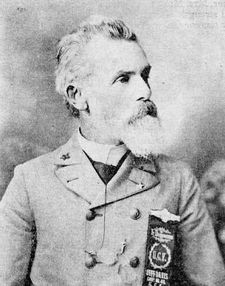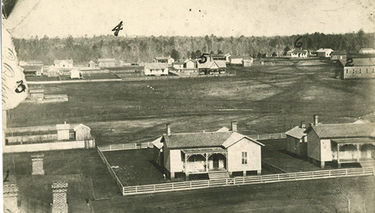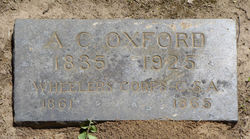A. C. Oxford
Allen Christopher Oxford (born June 6, 1835 in Carrollton, Pickens County; died September 30, 1925 in Birmingham) was the first photographer to open a studio in Birmingham, active between 1872 and 1885. Primarily a portrait photographer, he did take plates out to various locations in town, creating the earliest known photographic views of the city. Oxford was also politically active, serving on the Birmingham Board of Aldermen and as Mayor pro tem beginning in 1875.
Early life and service
Oxford was one of ten children born to John Whitehead and Elizabeth Oxford of Pickens County. He moved to a relative's farm in Mississippi when he was orphaned as a child. As a teenager he apprenticed at a photography studio in Tuscaloosa and worked as a clerk in Carollton. On November 14, 1861 he enlisted as a private with the McCaa Rangers in Columbus, Mississippi for service to the Confederacy in the Civil War. His unit was initially attached to the Pope-Walker Battalion, later enrolled as Company B, 4th Battalion, Mississippi Cavalry; and then merged into Company D, 8th Regiment Confederate Cavalry under the command of General Joseph Wheeler.
Following the Battle of Murfreesboro (Stone's River) on January 1, 1863. Oxford and a fellow sergeant Alfred Atwater carried their mortally-wounded Captain, B. B. McCaa, to a farmhouse near Shelbyville, Tennessee, where he died during the night. While preparing for his burial, the Confederates were surprised and captured by Union troops. According to a contemporary account, "Sergeant Oxford gave the Royal Arch Mason's society 'obligation' to the Captain, whereupon the prisoners were released."1
Oxford's equipment and skills as a photographer were evidently put into the service of the Confederacy as, in 1864, he managed to capture a photograph of a group of Union soldiers scaling Lookout Mountain. He reportedly spent 1865 in the "detached service", gathering intelligence.
After the war Oxford returned to West Alabama, marrying the former Aletheia Ann Whitlow of Old Spring Hill, Marengo County in 1868. The couple moved to Selma and Oxford entered a partnership with photographer Oliver Hubbard.
Birmingham
In 1872 the couple made the decision to move to the developing industrial town of Birmingham. Oxford paid $200 cash for a lot on the southwest corner of 2nd Avenue North and 21st Street where he erected a studio. Their first years in Birmingham were difficult as the town's development floundered during a national depression and the population was decimated by cholera. Knowing that the rest of the south was faring even worse, the Oxford's stayed put. They were founding members of First Methodist Church and Mr Oxford was active in the Masons and in the United Confederate Veterans. In addition to their downtown studio, they opened a gallery at the tourist resort of Blount Springs. Mrs Oxford worked as a seamstress and sold handwork to tourists at the Springs, and also gave piano lessons.
The Oxford's first daughter, Eliza Curtis, died in infancy on July 5, 1873 at the beginning of the epidemic in Birmingham. Her father staged a singular postmortem portrait of the girl bedecked with shears, knives and a doorknob to symbolize the closing of life and opening of the afterlife. In 1875 he won election to the office of Alderman under Mayor William H. Morris.
In 1876 Oxford had the opportunity to exhibit a selection of his views of the Birmingham District at the Centennial International Exhibition in Philadelphia, Pennsylvania. Surviving photos of the period preceding the exhibition depict the original Jefferson County Courthouse, the Relay House, various mines and general views of the city.
Alethea Oxford died in 1880 and A. C. Oxford later remarried, to the former Fannie Spiva of Camden, Wilcox County.
By 1881 Birmingham's fortunes were turning around and Oxford's business began thriving. He was selling his stereoviews of Birmingham in cities across the midwest and south and retailing views of exotic locales from his studio. His second daughter, Mary Josephine, was born, but Aletheia's health failed and she left him a widower. He took a room with board in the home of Mrs Ellen Stone on the 2300 block of 1st Avenue North until retiring to Blount Springs in 1885.
Oxford sold his downtown shop to merchant Christian Enslen and invested in real estate. He remarried and devoted himself to his family and to his fraternal activities. As an avid member of the Camp W. J. Hardee, No. 39 of the United Confederate Veterans, he was known for decorating his home in North Haven in "the colors of the Confederacy". He was identified in 1910 as "Brigadier General A. C. Oxford, Commanding 4th Brigade, Birmingham, Alabama". Oxford had a series of horses, all named "Dixie," and dogs, all named "Rebel".
In 1916 Oxford prepared scrapbooks with examples of his photographic work, and disposed of the remainder of his prints and plates. His second wife, Fannie, died in 1919. A. C. Oxford died in 1925 and is buried at Oak Hill Cemetery. He was survived by a son-in-law, two granddaughters and several nieces and nephews.
Notes
- Two accounts of the incident conflict in minor details, with one incorrectly giving the date as February 1863. And although he is referred to as "Sergeant Oxford", official records suggest that he concluded his service with the rank of Private.
References
- J. A. G. (1863) Account concerning the service of Leonidas A. Horton - quoted in Scott Owens Horton Family History - accessed August 2, 2006
- City Directory of Birmingham and Gazetteer of Surrounding Section for 1884-5 (1884) Volume II. Atlanta, Georgia: Interstate Directory Company
- "Maj. A. C. Oxford" (December 1899) Confederate Veteran Vol. 7, No. 12, p. 551
- "Birthday of Lee Being Observed" (January 19, 1904) The Birmingham News, p. 6
- "Maj. A. C. Oxford" (December 1925) Confederate Veteran Vol. 33, No. 12, p. 468.
- Keeton, Jane E. (1987) "Birmingham's First Three Decades: A Photographic Essay." Journal of the Birmingham Historical Society.
- Robb, Frances (August 2, 2006) "Success and Sorrow: A. C. Oxford, Birmingham's First Resident Photographer." Lecture delivered at the Birmingham Public Library.
- Miller, George Knox (2007) An Uncompromising Secessionist: The Civil War of George Knox Miller, Eighth (Wade's) Confederate Calvary. Edited by Richard M. McMurry. Tuscaloosa: University of Alabama Press ISBN 0817315314
- Robb, Frances Osborn (2017) Shot in Alabama: A History of Photography, 1839–1941. Tuscaloosa: University of Alabama Press ISBN 081731878X
External links
- Allen C. Oxford (sic) at Findagrave.com



